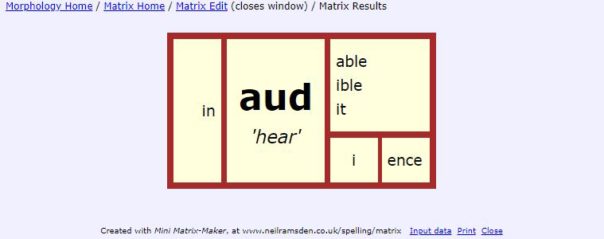
Mini River close to Millerton Lake taken by Eliza on Feb. 28, 2009
Five years ago I took an online course to learn how to use the Orton Gillingham approach. After nine years in the public school system as a special education teacher, I wanted a systematic method to remediate reading delays. The course was affordable and the director provided curriculum and extensive support. I used the materials for three years. Parents of a child that I helped approached me recently and thanked me for my work with their daughter. Without my help, she would not be reading.
What changed my mind about Orton Gillingham?
It was evident that to be accepted by the establishment of Dyslexia “experts” I would have to pursue extensive additional training at a great cost of time and money. I wanted to be sure that this was the direction to go.
I signed up for an online conference sponsored by the Dyslexia Training Institute. Gina Cooke’s presentation was my first introduction to Structured Word Inquiry. Gina defined orthography as “Human thought made visible as text. ” Orthography was made up of morphology, etymology, and phonology. Gina was a linguist specializing in helping people with language delays. This made sense to me.
Orthographic investigation wasn’t something new or invented by a curriculum designer. This was an authentic study of how the English language worked.
How Does Structured Word Inquiry Work?
When I study with my colleagues and my students we engage in scientific investigations. We indulge in curiosity and nurture our love of learning.
English is a well-ordered system. When we look at English closely, we find underlying patterns which explain the structures and meaning of words.
Studying the patterns within the English language helps learners read, spell, and comprehend. Learners choose words that intrigue them and participate in dynamic scientific investigations with a trained adult.
Because English has a logical orthographic system, learners make connections over time and retrieve information from working and long-term memory. Drills and memorization are not part of the process.
Leveled text is unnecessary. Learners are free to choose their own reading. When reading text, learners are invited to “spell out” difficult words. Often, spelling out is enough to clarify difficulties. While we spell out words we identify morphemes such as affixes and bases. To keep the reading going, difficult words are read to the learner.
This is particularly suited to learners who are easily bored and who have become frustrated with drills and memorization.
The process builds higher level thinking and supports curiosity, which are both very important components of success in school and life.
How do we do orthographic investigations?
Our start point is the assumption that meaning drives spelling and structure. We read a word and identify what it means to us. We might also compose a sentence with the word in context. If we don’t know what it means, we look it up.
Morphemic Families
After meaning, we look at the building blocks of words known as morphemes. Looking at the morphemic structure, we investigate to determine the base, affixes, connecting vowels, and any other elements that might explain the structure of the word. Learners can connect words based on shared etymological roots, which builds comprehension and understanding of morphology.
An example of a morphemic family is <audience>, <audit>, <inaudible>, and <audible>. The shared base is <aud>.
Here are word sums that break down the words into morphemes:
<aud> + <i> + <ence>–> <audience>
<aud> + <it>–> <audit>
<in> + <aud> + <ible>–> <inaudible>
<aud> + <ible>–> <audible>

Here is a word matrix that illustrates the relationships within these words:
Etymological Families
Etymological families contain words that share an etymological root, such as medium, meridian, milieu, and mean. The Latin root, in this case, is medi (us) “middle, between.”
Although these words share the same etymological root, they don’t share the same spelling. They would not fit into a matrix because a matrix is designed to show words that share common
spelling in current usage.
Grapheme-Phoneme Correspondences
The pronunciation of a word is the last step in an orthographic investigation. Once we know the base and the affixes, we represent the sounds using the symbols of the IPA (International Phonetic Alphabet.) This is the last step because the sounds of the letters will change with the morphemic structure of the word. For example, the base <please> is represented by these symbols: /’pli:z/. The word <pleasant> is represented by these symbols /’plɛzənt/.
Contrast with Orton Gillingham
Orton Gillingham starts with the sounds words make. This approach requires students to memorize letter sounds and patterns of language. However, focusing on the sounds is misleading. Letter-sound correspondence is based on the meaning of words, not on the written graphemes that are used to spell out words. For example, the word <please> is pronounced /’pli:z/ but the word <pleasant> is pronounced /’plɛzənt/. By focusing on the sounds, we lose the essential connection between these two words. Another advantage of Structured Word Inquiry over Orton Gillingham is that when we recognize morphemic parts of words spelling improves because we don’t rely on “sounding out” for spelling. While phonics is enough for most learners, those who have neurological delays in reading need to understand the deep structure of language to master reading and spelling.
Ongoing debate
There is an ongoing debate about whether orthographic investigation is appropriate for every learner. A conservative point of view might hold that each student’s needs come first. For some learners, explicit phonics might be necessary to build skill in letter-sound correspondence. We know that the Orton Gillingham approach is effective for many students. However, we also see that many students reach a point where they resist memorization and rote learning. These learners might respond to the orthographic investigative process, which is not an “approach”. It’s a process of learning language via scientific inquiry.
References
Bowers, P. (2018, June). Online Workshop.
Cooke, G., & Mills, S. (2018). Matrix Study Sheets Volume 2. LEX and LIV(E).
Cooke, G. (2017). Where Phonology Fits. Dyslexia Training Institute.
Schnotz, W., & Kurschner, C. (2007). A Reconsideration of Cognitive Load Theory. Educational Psychology Review, 469-508.
I want to express my deepest appreciation for the Structured Word Inquiry learning community who proofread this blog post and provided much-appreciated input. May we continue to share the joy of scholarship!
The image for this blog post is intended to bring to mind an expression of Heraclitus, the Greek philosopher: You don’t step into the same river twice because it’s never the same river, and you’re never the same person. This philosophy describes the joy we feel when we study English orthography and learning in general.
 Dvora’s introduction to teaching came when her youngest child was expelled from private religious school for fidgeting.
Dvora’s introduction to teaching came when her youngest child was expelled from private religious school for fidgeting. Currently, Dvora is a practicing educational therapist. Her work as an educational therapist started in 2013 after she left her full-time teaching job as a resource specialist at a middle school in Los Angeles. She works with Individuals and provides small group instruction to remediate and enrich student learning. Dvora’s approach integrates a mind body point of view, and the scientific method to support awareness and higher-level thinking. Dvora works collaboratively with families, school staff and other providers.
Dvora is a graduate of the LAUSD District Intern Program. She holds a California Teaching Credential in Special Education, a master’s degree in Counseling Psychology from Loyola Marymount University, and a BA in Sociology from University of California, Los Angeles (UCLA). She is also a licensed Marriage and Family Therapist.
You can read more of her ideas on her blog: http://www.dvorakravitz.com/
She can be reached at mrsdvorakravitz@gmail.com





